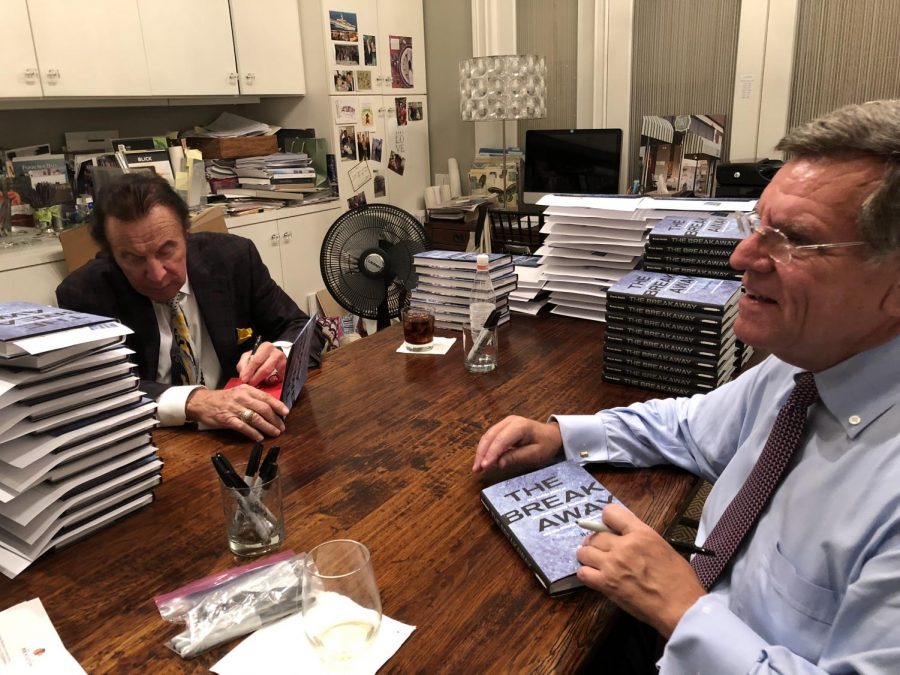Wirtz, Esposito sign books for charity in Winnetka
Owner and Hall of Goalie support teams foundation, booster club
Blackhawks chairman Rocky Wirtz and legend goaltender Tony Esposito made a stop near New Trier last week, holding a book signing at the Maze Home shop on Elm Street in Winnetka. They were promoting “The Breakaway” by Bryan Smith, a nonfiction story that details the history of the Wirtz family’s ownership of the Blackhawks. It spans from Wirtz’s grandfather Arthur and his father William to the present day, where Wirtz has helped lead the Blackhawks to three Stanley Cup Championships since he took over after his father’s death in 2008.
“Bryan wanted to write a book and he talked to me,” said Wirtz, explaining how Smith gained such an insider perspective on the family. “I said that I’d be happy to collaborate with you on the book, under two circumstances. One, it has to be accurate. Two, any money we make off of it has to go to the Chicago Blackhawks foundation.”
The second ultimatum is especially important to Wirtz and Esposito. The Blackhawks foundation works with both the team and the community to make sure the former makes a positive impact on the latter.
For example, very often you will see current players and coaches visit area hospitals to “participate in games and interact with children.” They have visited, among others, NorthShore University HealthSystem, Lurie Children’s hospital, and Ronald McDonald Children’s hospital of Loyola University Medical Center, according to their website.
The book signing was hosted by Maze Home, a home supply store in Winnetka, where Wirtz grew up (he attended North Shore Country Day). While all of the book sales go to the Blackhawks foundation, 10 percent of the non-book event sales go to the New Trier Booster club.
“We wanted to work with a local high school and a big hockey program and had enjoyed working with the NT Booster Club for an annual fund raiser, so we thought they’d be a great fit for ‘The Breakaway event,’” said Sara Kratz, manager of Maze Home.
The crux of “The Breakaway” deals with the Blackhawks’ revival under Wirtz and team president John McDonough, after William Wirtz’s death. The team was an annual last-place finisher in the most recent pre-Kane and Toews years, and that was the least of their problems. The elder Wirtz had developed a stingy attitude towards his players and fans, refusing to even put the home games on TV.
“I think the biggest thing [when I took over the team] was reconnecting with the fans, which are the customers,” said Wirtz. “And the players, which are your employees. We had burned so many bridges and if we could reconnect them, I knew we had a fighting chance.”
Esposito was one of the former players who the team had to reconnect with. He is a record-setting goalie who entered the Hockey Hall of Fame in 1988, and he was at the book signing because he wrote the foreword for the book
“Rocky Wirtz asked me to [write the foreword], and I agreed because I thought it was an honor to do it. I read the book and it’s quite enlightening. It was fun, and I enjoyed doing it,” he said.
He wrote in the foreword how thrilled he was to get a call from the Blackhawks to “come back,” to join the organization as an ambassador instead of in isolation from the team because he, like many former Hawks, did not leave the organization on good terms.
“They make it friendly now! When you’re done playing, they don’t treat you like an afterthought,” he said in comparison to their old practices.
Esposito said that the darkest era for the Blackhawks was in the 1990s, when star players like Jeremy Roenick and Steve Larmer left after ownership wasn’t inclined to pay them, hence the “Dollar Bill” nickname.
Consistently during that time, about eight thousand people would be in the stadium for games, compared to a normal sell out of 20 thousand today, according to Esposito.
Esposito is also involved in the Blackhawks foundation, as are many former players. “I do whatever they ask me to do,’’ he said. “Like the golf outings, and functions to help kids. And I think that’s really important, because then the community gets to know you, the hockey player, as a person.”






































